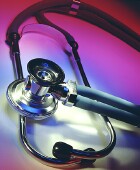
THURSDAY, Feb. 27, 2014 (HealthDay News) — Stethoscopes help diagnose and heal, but this primary tool of physicians also has significant potential to spread germs from patient to patient, a new study reports.
The diaphragm of a stethoscope — the round piece placed against a patient’s body — can become filthy with antibiotic-resistant bacteria such as potentially deadly MRSA, researchers found.
They discovered that a diaphragm will pick up more bacteria during a patient examination than any part of the doctor’s hand except the fingertips.
The tube of the stethoscope also can become laden with bacteria, and the contamination level of both the diaphragm and the tube increases with the amount of bacteria on the doctor’s fingertips, the study said.
“Germs are acquired from the patient’s skin in contact with the stethoscope, the same way hands usually get colonized with the patient’s germs,” said study senior author Dr. Didier Pittet, director of the Infection Control Program at University of Geneva Hospitals, in Switzerland.
“The important implication is that the stethoscope, whether used by a doctor, a nurse, an assistant nurse or any staff, needs to be cleansed after each use,” said Pittet, who also heads the World Health Organization’s Collaborating Centre on Patient Safety at the hospitals.
The potential of health care professionals to inadvertently spread disease through their tools or attire is becoming an area of focus because of concerns about the rise of antibiotic-resistant “superbugs.”
Epidemiologists — experts who study disease patterns and causes — raised the possibility in January that doctors may want to ditch their traditional attire of white coat and necktie, since the articles of clothing can become contaminated and are not easily washed between patients.
The new study compares the level of contamination on physicians’ hands and stethoscopes.
In the study, physicians examined 71 patients using sterile gloves and a sterile stethoscope.
After doctors completed the examination, researchers measured the bacteria on the tube and diaphragm of the stethoscope. They also tested the fingertips, ball of the thumb, palm and back of the physicians’ hands for bacteria.
They found that the stethoscope and the fingertips tended to be more contaminated than all other parts of the physicians’ hands, both with bacteria in general and MRSA (methicillin-resistant Staphylococcus aureus) specifically. They also found that the contamination level of the stethoscope increased with contamination of the hands.
“Although infection cross-transmission from one patient to another has not been demonstrated in this study, it seems clear that staff and doctor stethoscopes constitute an extension of their fingertips in terms of risk for germ’s cross-transmission,” Pittet said.
“Hand hygiene remains the primary measure for the prevention of hospital infections, and appropriate handling of stethoscopes — their cleansing immediately after use — should be part of good patient care practices,” Pittet said.
The study results are published Feb. 27 in the journal Mayo Clinic Proceedings.
Leaders of two primary care medical societies said they weren’t surprised by the study findings, and called on doctors to practice better hygiene.
“The numbers are alarmingly low on the frequency of handwashing among physicians,” said Dr. Charles Cutler, chair of the American College of Physicians Board of Regents. “We’ve got to get it to 100 percent between patients. Anything less than that is not good enough.”
Medical schools emphasize that students should regularly wash their white coat and tie, and wipe down their stethoscopes between patients, said Dr. Daniel Spogen, chair of family and community medicine at the University of Nevada School of Medicine and a member of the American Academy of Family Physicians’ board of directors.
“Being a practicing physician, there are things that we carry from room to room between exams, and the stethoscope is the main one,” Spogen said. “We encourage them to douse their stethoscopes between patients, but some days when you’re moving quickly between patients, you sometimes can forget.”
Cutler and Spogen said patients should feel free to speak up and ask health care professionals to wipe down a stethoscope before using it. Don’t worry about offending your doctor, they said.
“If I were a patient, I would want to be certain that took place,” Cutler said. “If the doc is offended, the doc better go back to school.”
More information
For more information on antibiotic-resistant bacteria, visit the U.S. Centers for Disease Control and Prevention.
Copyright © 2024 HealthDay. All rights reserved.

